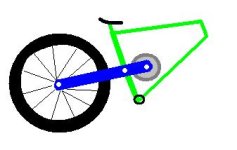John in CR
100 TW
I'm headed toward using moto wheels for the stronger wheel, better and cheaper tires, and better brake solutions with big silent hubbies as mid-drives. For the trail bike I want to build for myself I want to shoot for suspension like a freeride bike, so the added unsprung weight of the moto wheel seems like a detriment. AFAIC the motor has to be somewhere on the swingarm, but behind the pivot point adds to unsprung weight and lengthens the swingarm to increase the leverage of the wheel's unsprung weight. Motor in the pivot may be the ideal but is proving difficult to fit.
How about extending the swingarm and mounting the motor in front of the pivot, so it's effect is negative unsprung weight to offset the moto wheel's extra weight. I understand it will negatively affect the inertia of the rear suspension system, but could there be any benefit in doing something like this?
Please forgive the crude drawing of what I mean?

How about extending the swingarm and mounting the motor in front of the pivot, so it's effect is negative unsprung weight to offset the moto wheel's extra weight. I understand it will negatively affect the inertia of the rear suspension system, but could there be any benefit in doing something like this?
Please forgive the crude drawing of what I mean?




